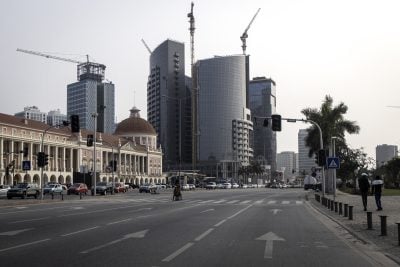In 2015, Diamond Bank’s profits fell off a cliff. Back in 2014, the Nigerian bank’s profit before tax was a respectable N24.4bn ($122m). In 2015, profit plummeted to just over N5bn. When the bank’s financial statement was made public towards the end of March, the bank’s share price suffered a similar fate, falling to an all-year low of N1.15. Things weren’t looking too good for Nigeria’s tier two bank. “The main reason for the drop-off in our profits were impairments due to the fall in the oil and gas price and our exposure to the sector,” says the bank’s chief executive, Uzoma Dozie.
“Were we overexposed to the oil and gas sector? Perhaps we were,” admits Dozie. “But Nigeria itself is overexposed and highly concentrated in these sectors. The country relies on oil for trade imports, on oil for building foreign currency reserves and on oil for propping up the budget. Eighty per cent of total loans by banks in Nigeria go to less than 100 companies in Nigeria. Just think about how limited that is. It’s a highly concentrated country in many ways.
“So yes, we may have been overexposed to the oil and gas sector from a bank perspective, but from a Nigeria perspective, I don’t think we were,” he says.
Despite a rebasing exercise back in 2014 which declared it Africa’s largest economy and asserted that the country was a lot more diverse than originally thought, Nigeria remains highly reliant on oil, which accounts for around 70% of government revenue. Nigerian banks fuel business in Nigeria, much of which is connected – directly or indirectly – to the oil and gas sector.
According to data compiled by the Central Bank of Nigeria, total credit to the oil and gas sector in Nigeria is around 25%.Overexposure to natural resources has caused major meltdowns for some of Nigeria’s biggest banks. With the collapse in the global oil price from heady heights of $110 a barrel in mid-2014 to a meagre $30 in February of this year, profits for Nigerian banks dived, impairment charges grew and nonperforming loans (NPLs) soared as businesses struggled to meet loan repayments. According to data from the Central Bank of Nigeria, NPLs rose by 78% year-on-year to N650bn in 2015. Ecobank, Skye Bank, and FCMB were just some of the others to issue profit warnings before the announcement of their full financial year results for 2015. Diamond Bank was in good company.
“Over the years, we have built relationships with the oil and gas sector and this accounts for around 30% of our lending portfolio. But as the currency began to devalue, even though we were looking to bring this down to around 20%, the share of the oil and gas sector on our portfolio actually increased to around 35%,” says Dozie. “The devaluation of the currency made our exposure to the oil and gas sector worse in naira terms.”
Now oil prices have settled at around $40 a barrel. “But much of the decline in risk due to price has been replaced with geo-political risk following numerous terrorist attacks on oil fields in the Niger Delta,” says Ronak Gadhia, equity analyst at Exotix based in London. In recent months, oil giants Shell and Chevron have both wound down some of their operations in the region.
“The oil industry in Nigeria is not dead, but production is an issue. In the beginning of 2015, Nigeria was producing between 1.9 to 2m barrels of oil a day, now it has fallen to 1.4m with terrorism and vandalism to blame,” says Dozie. “And in any case, people don’t want to sell oil at $40 a barrel. I think some companies will hold on to the oil until the oil price creeps up.”
With the fall in the oil price, Nigeria has seen its currency collapse as import costs have soared on the back of dwindling oil exports. While the official exchange rate was maintained at around N200 to the dollar before the currency peg was finally removed in June, black market rates were closer to N350. At time of going to print the official rate had settled at around N282 to the dollar.
“Look at Nigeria today: you have a formal sector that is small and an informal sector which is huge and market rates don’t represent the formal exchange rate at all. If we aren’t able to fix this, we will probably have a lot more problems on the horizon,” says Dozie.
“I do think one way to go would be to introduce a two tier market in Nigeria: one rate for essential imports and another for non-essential items. This could take some of the pressure off our businesses. To a certain extent, the market is already doing this so why not introduce it formally?” Nigeria’s Central Bank seems to have listened to Dozie’s plea.
Some banks are making resolute efforts to diversify away from the oil and gas sectors in Nigeria, with encouragement from the government in sectors such as agriculture and manufacturing. Meanwhile, Diamond Bank has been ramping up its retail banking sector and investing in its mobile banking platform. First quarter results show that Diamond Bank could be making a comeback. While impairment charges were still high, profit after tax for the first quarter in 2016 was N5.7bn, more than the entire profit after tax for 2015.
“We are building our retail business from a lending perspective,” says Dozie. “Three years ago we had 4m customers; now we have 11m. And with our drive for financial inclusion, we need to make sure that the change is driven by digital and mobile developments. To increase the level of engagement of our customer base, we need to move them from branch to mobile. It’s a development that I think is paying off. We have moved customers from working 100% in branch to 80% through alternative channels. We now have 1.2m people using our mobile banking application.”
But is it that simple? “Diamond Bank has been ramping up its retail portfolio, but I’m not sure the bank’s numbers match its strategy yet,” says Gadhia.“Loans on the retail side are relatively small whereas just one corporate loan can tip the balance in a bank’s portfolio massively. Since 2009, Diamond Bank’s retail book has sat between 12 to 14% of its total book and consumer credit sits at 3.2% of total loans, which is actually less than it was back in 2009.”
Diamond Bank’s results for 2016 will be very telling.
Kanika Saigal
Want to continue reading? Subscribe today.
You've read all your free articles for this month! Subscribe now to enjoy full access to our content.
Digital Monthly
£8.00 / month
Receive full unlimited access to our articles, opinions, podcasts and more.
Digital Yearly
£70.00 / year
Our best value offer - save £26 and gain access to all of our digital content for an entire year!
 Sign in with Google
Sign in with Google 


